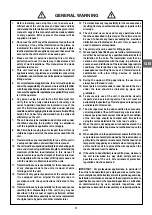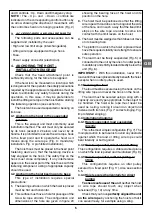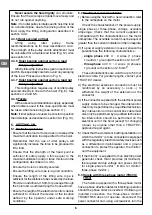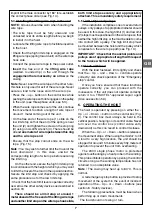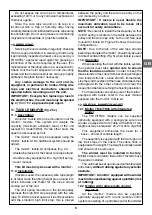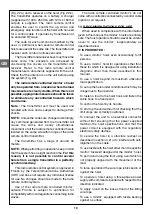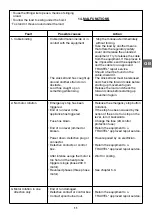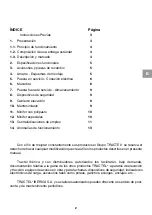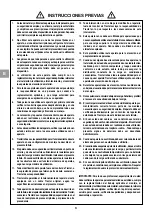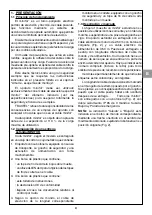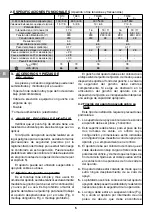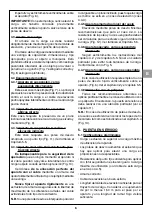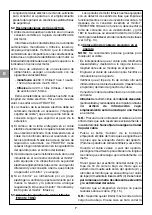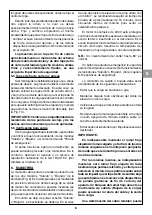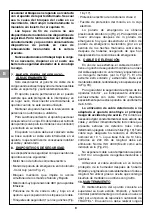
7
imprint in the male connector by 180° to re-establish
the correct phase order (see Fig. 14).
5.4 Installing the lifting wire rope in the unit
NOTE : Gloves should be worn when handling the
wire rope.
• The wire rope must be fully unwound and
untwisted over its entire length before you begin
to install it in the hoist.
• Lubricate the lifting wire rope to facilitate insertion
in the hoist.
• Check that the high limit stop is engaged on the
lifting wire rope (spring toward unit) on the wire rope
hook side.
• Connect the power wire rope to the power outlet.
• Insert the free end of the lifting wire rope
(welded, rounded tip) in the unit through the
engagement hole marked by an arrow on the
casing.
Note : Never insert the wire rope in the other hole ;
this hole is only used for exit of the wire rope. Never
secure a load to the loose end of the wire rope.
• Press the « up » button on the control box while
pushing the wire rope so that it engages on the pulley
in the unit. (see three-phase units, see 5.3).
• When the wire rope comes out of the unit, continue
the movement to obtain a length of wire rope of
around 1 meter coming out of the unit.
• On the free end of the wire rope (1), slide on the
low limit stop so that the end of the spring is near
the unit (2) and tighten the screw on the stop ring
(3) using an ALLEN wrench (4). There should be
at least one meter of wire rope between this ring
and the wire rope end.
• Ensure that the stop cannot slide on the wire
rope. (Fig. 15).
Note : You may wish to further limit the travel of the
load downward ; in this case, unwind the
corresponding length of wire rope before securing
the limit ring.
On the other end, secure the high limit stop ring
in accordance with the height at which you may want
to limit the travel of the load in the upward direction.
Secure the limit stop and check it by applying the
same procedure as for the low limit stop.
• Check that the hoist limit levers operate correctly,
as well as the other safety devices as described in
section 18.
There should be a limit stop at around 1
meter ahead of the free end of the lifting wire rope
and another limit stop on the wire rope hook slide,
both limit stops securely and appropriately
attached. This a mandatory safety requirement.
5.5 Limit stops and pulleys
If the installation comprises one or several return
pulleys, only pulleys of appropriate diameter should
be used. In this case, the high limit (1) and low limit
(2) stops must be positioned on the wire rope so that
neither the high limit stop or the load be able to come
into contact with a pulley. The high limit stop must
be mounted between the hoist and the pulley which
is nearest on the wire rope path (see Fig. 13).
IMPORTANT : Check that the anchor points and
pulleys are of appropriate strength with respect
to the forces which will be applied.
5.6 Check with load
With the load fastened, lift it slightly and check
that the « Up » and « Down » controls operate
correctly; also check operation of the “Emergency
stop” control.
Once you have ensured that these functions
operate correctly, you can proceed with the
maneuvers. If the unit does not operate correctly,
return it to a TRACTEL
®
-approved repair agent
(Also see section 5.3)
6. OPERATING THE HOIST
The hoist is operated by pressing on either the «
Up » or « Down » button on the control box (Fig.
2). The control box must always be held in the
vertical position, hanging on its control cable. Never
turn over the control box (control cable entry
downward) as this can result in control mistakes.
When the « Up » or « Down » button is released,
the movement stops. When using the minifor
™
to lift
a load to a very high location, the unit should be
stopped for around 15 minutes every fifty meters of
operation to prevent the unit from overheating.
The 230V single phase motor is protected
against overheating by a heat probe in the winding.
This probe inhibits operation by opening the control
circuit so long as the winding temperature has not
returned to an acceptable value.
Note : The casing may heat up to 80°C. This is
normal.
A red emergency stop button is provided to stop
movement of the system in the event of incorrect
operation of the « Up » or « Down » buttons (see
section 8 : Safety devices).
The following precautions must be taken when
performing up or down movements :
• The load should not swing or turn.
GB



